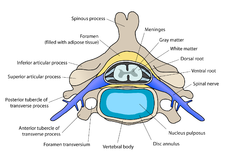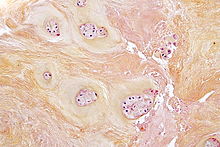- Intervertebral disc disorder
-
Intervertebral disc disorder Classification and external resources 
Cervical vertebra with intervertebral discICD-10 M50-M51 ICD-9 722  Micrograph showing a fragment of a intervertebral disc demonstrating degenerative fibrocartilage with loss of nuclei and nests of chondrocytes, as seen in degenerative disc disease. HPS stain.
Micrograph showing a fragment of a intervertebral disc demonstrating degenerative fibrocartilage with loss of nuclei and nests of chondrocytes, as seen in degenerative disc disease. HPS stain.
A intervertebral disc disorder is a condition that involves deterioration, herniation, or other dysfunction of an intervertebral disc.
As people age, the nucleus pulposus begins to dehydrate, which limits its ability to transfer and distribute loads between the vertebrae. These loads are instead transferred non-uniformly through the annulus fibrosus, which undergoes progressive, structural deterioration. While this may not cause pain in some people, in others one or both of these may cause chronic pain.
Pain due to the inability of the dehydrating nucleus pulposus to absorb shock is called axial pain or disc space pain. One generally refers to the gradual dehydration of the nucleus pulposus as degenerative disc disease.
When the annulus fibrosus tears due to an injury or the aging process, the nucleus pulposus can begin to extrude through the tear. This is called disc herniation. Near the posterior side of each disc, all along the spine, major spinal nerves extend out to different organs, tissues, extremities etc. It is very common for the herniated disc to press against these nerves (pinched nerve) causing radiating pain, numbness, tingling, and diminished strength and/or range of motion. In addition, the contact of the inner nuclear gel, which contains inflammatory proteins, with a nerve can also cause significant pain. Nerve-related pain is called radicular pain.
Herniated discs go by many names and these can mean different things to different medical professionals. A slipped disc, ruptured disc, or a bulging disc can all refer to the same medical condition.
Protrusions of the disc into the adjacent vertebra are known as Schmorl's nodes.
Dorsopathies / spinal disease (M40–M54, 720–724, 737) Deforming dorsopathies OtherSpondylopathy inflammatory: Spondylitis (Ankylosing spondylitis) · Sacroiliitis · Discitis · Spondylodiscitis · Pott diseaseBack pain Intervertebral disc disorder M: JNT
anat(h/c, u, t, l)/phys
noco(arth/defr/back/soft)/cong, sysi/epon, injr
proc, drug(M01C, M4)
Categories:- Musculoskeletal disorders
- Disease stubs
Wikimedia Foundation. 2010.
